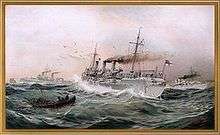SMS Jagd
 SMS Jagd | |
| History | |
|---|---|
| Name: | SMS Jagd |
| Builder: | AG Weser |
| Laid down: | 1887 |
| Launched: | 7 July 1888 |
| Commissioned: | 25 June 1889 |
| Fate: | Scrapped, 1920 |
| General characteristics | |
| Class and type: | Wacht-class aviso |
| Displacement: | 1,499 metric tons (1,475 long tons; 1,652 short tons) |
| Length: | 85.8 m (281 ft 6 in) o/a |
| Beam: | 9.66 m (31 ft 8 in) |
| Draft: | 3.74 m (12 ft 3 in) |
| Propulsion: | 2 × 3-cylinder double expansion engines, 2 shafts |
| Speed: | 19 knots (35 km/h; 22 mph) |
| Range: | 2,440 nmi (4,520 km; 2,810 mi) at 9 kn (17 km/h; 10 mph) |
| Complement: |
|
| Armament: |
|
| Armor: |
|
SMS Jagd was an aviso of the Imperial German Navy, the second and final member of the Wacht class. She had one sister ship, Wacht. Jagd was laid down in 1887 at the AG Weser shipyard, launched in July 1888, and commissioned in June 1889. She served in the German fleet for the next fifteen years, until she was withdrawn from active duty in 1904. Thereafter, she was used as a harbor ship. In 1910, she was stricken from the naval register and hulked. She was later used as a torpedo training platform until 1920, when she was sold for scrapping.
Design

Jagd was 85.5 meters (281 ft) long overall and had a beam of 9.66 m (31.7 ft) and a maximum draft of 3.74 m (12.3 ft) forward. She displaced 1,499 metric tons (1,475 long tons; 1,652 short tons) at full combat load. Her propulsion system consisted of two angled 3-cylinder triple expansion engines. Steam for the engines was provided by four coal-fired locomotive boilers. The ship's propulsion system provided a top speed of 19 kn (35 km/h; 22 mph) and a range of approximately 2,860 nautical miles (5,300 km; 3,290 mi) at 10 kn (19 km/h; 12 mph).[1] Jagd had a crew of 7 officers and 134 enlisted men.[2]
As built, the ship was armed with three 10.5 cm (4.1 in) K L/35 gun placed in single pivot mounts. The guns were supplied with a total of 180 rounds of ammunition. Jagd also carried three 35 cm (14 in) torpedo tubes, one mounted submerged in the bow and the other two in deck-mounted launchers on the broadside. In 1891, four 8.8 cm SK L/30 guns in single mounts were added. The ship was the first German aviso to carry armor: a 10 mm (0.39 in) thick deck, along with 25 mm (0.98 in) of armor plating for the conning tower.[3]
Service history

Jagd was laid down at the AG Weser shipyard in Bremen in 1887. She was launched on 7 July 1888, after which fitting-out work was completed. The finished ship was commissioned into the German fleet on 25 June 1889.[4] She served in the fleet starting in 1889.[2] Jagd served in the Training Squadron in 1891 as a torpedo boat flotilla leader, along with the avisos Blitz and Pfeil. During the annual summer exercises, the Training Squadron served as the hostile fleet, and conducted a mock attack on the harbor at Kiel.[5] In 1893, Jagd was assigned as the dispatch vessel for the II Division of the Maneuver Squadron.[6] During the 1896 annual maneuvers, Jagd was assigned to the I Division.[7]
She was transferred to the I Division in 1897, where she participated in the annual fleet exercises in August and September.[8] After the conclusion of the maneuvers, the Maneuver Squadron returned to its home port in Wilhelmshaven.[9] She served in the defending squadron during the August–September 1900 maneuvers.[10] In 1904, Jagd was withdrawn from active service and used as a harbor ship. Jagd was stricken from the naval register on 14 May 1910 and subsequently hulked. She was based in Friedrichsort outside Kiel and used as a firing platform for torpedo training until she was broken up for scrap in 1920 at Rüstringen.[2]
Notes
References
- Garbett, H., ed. (December 1897). Journal of the Royal United Service Institution. London: J. J. Keliher & Co. XLI. Missing or empty
|title=(help) - Gardiner, Robert, ed. (1979). Conway's All the World's Fighting Ships: 1860–1905. London: Conway Maritime Press. ISBN 0-85177-133-5.
- Gröner, Erich (1990). German Warships: 1815–1945. Annapolis, MD: Naval Institute Press. ISBN 0-87021-790-9.
- Knepper, Orlo S. (October 1901). "The Naval Maneuvers of 1900". Notes on Naval Progress. Washington, DC: Office of Naval Intelligence: 363–418.
- "Naval and Military Notes". Journal of the Royal United Service Institution. London: Royal United Services Institute for Defence Studies. XXXVII (185): 811–823. July 1893. doi:10.1080/03071849309416563.
- Notes on Naval Progress. Washington, DC: Office of Naval Intelligence. October 1896. Missing or empty
|title=(help) - Notes on the Year's Naval Progress. Washington, DC: Office of Naval Intelligence. July 1892. Missing or empty
|title=(help)